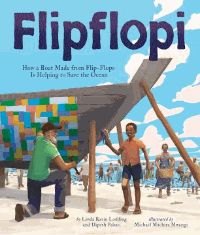Flipflopi, how a boat made from flip-flops is helping to save the ocean
 Flipflopi, How a Boat Made from Flip-Flops Is Helping to Save the Ocean
Flipflopi, How a Boat Made from Flip-Flops Is Helping to Save the Ocean
Picture Book / Kenya / Ages 4-8
Beaming Books
March 14, 2023
42

Juma wants to go fishing with Babu Ali. But when they get to the beach, it's full of plastic waste and flip-flops washed up from the ocean. Juma thinks the flip-flop floating in the water looks like a boat, and that gives Babu Ali an idea.
This uplifting and inspirational picture book is based on the true story of the first sailing boat made entirely out of plastic waste collected along the Kenyan coast. It is set in a picturesque coastal community on Lamu island. On one of their regular fishing trips, Juma and his grandfather are horrified at the sight of flip flops and plastic waste washing up on the beach. The sea is central to the life of their community and this kind of ocean pollution directly threatens their environment. Something had to be done. So Juma and his grandfather, a master boat builder, embark on a mission to make something beautiful out of the polluting pieces of plastic. With the help of their community they build a traditional dhow sailboat made out of plastic waste.
Juma, the main character, is a buoyant young boy with a soaring imagination and an unwavering sense of responsibility to protect his environment. After becoming aware of the continuous flood of waste onto the beach, he takes it upon himself to collect the colorful pieces of used flip flops and plastic trash into a pile. As he watches this pile of “takataka” (waste) grow and grow, he ponders all the effects this waste has on the waters, the ocean life and his community. Juma comes up with the idea to melt down this plastic and transform it into a dhow. After all, his grandfather, Babu Ali is a master boat builder! From here, the story unfolds, with Juma and his grandfather rounding up their community to build a boat out of used flip flops that are polluting the ocean. The community gathers this trash and turns it into piles “as high as Mt. Kilimanjaro.” Then they work together to hammer, sand and glue the waste into a boat they name Flipflopi.
The illustrations by Kenyan artist Micheal Machira Mwangi are a vivid look into the charming beauty of the Lamu landscape, and the culture of its majority-Muslim inhabitants. Some women depicted in the story are wearing leso or kanga, a popular and versatile cloth worn throughout the Indian Ocean region. Other women are wearing long dresses known as buibui. Some of the men are dressed in a long robe called kanzu, while others are shown wearing trousers. Most of the adults are wearing head covering: the men either have a small round kofia (kufi/ prayer cap) or a Western-style baseball cap while the women are mostly wearing hijabs.
The sense of community and collective purpose is wonderfully portrayed in this story. It also inspires readers to reflect on their own role in protecting the oceans and other ecosystems. On the last pages, the authors share general facts about the magnitude of ocean pollution and specific suggestions on how readers can apply environmentally conscious habits in their daily lives.
The authors also included a section about the real life boat which was launched in September 2018. Originally, the idea was born in the minds of environmentalists Ben Morrison and Dipesh Pabari, who is also the co-author of this picture book. Their idea took on wings (or sails) once they recruited Master dhow boat builder Ali Skanda, who comes from a family of carpenters and dhow builders in Lamu. Together, the team built Flipflopi, and have since used it in campaigns to create greater awareness of ocean pollution around the globe.
This picture book shines a light on the masterful work of traditional dhow builders like Ali Skanda and offers educators the opportunity to apply STEM lessons to traditional dhow building. Students can learn the elements of a boat, the history of the dhow and how it is made. On the Web Site (theflipflopi.com), students can even watch videos on how the Flipflopi was constructed using plastic waste materials, including flip flops.
Finally, educators can guide their students in learning more about Lamu Island and particularly Lamu Town which is a UNESCO World Heritage Site and the oldest and best preserved Swahili settlement in East Africa.
Highly recommended
Reviewed by Vanessa Oyugi, Ph.D.
Howard University
Published in Africa Access Review (April 26, 2024)
Copyright 2024 Africa Access

Students learned that Kenya is on the coast and there is trash in the ocean.
Most importantly, students learned about making a boat from trash.
They especially liked the word takataka (trash).
The students enjoyed learning that trash cleanups make a difference.
Elementary Librarian DC Public Schools
My students learned that everyone works together in the community. They liked that the people never gave up they became more resourceful.
The students enjoyed that they helped one another. They liked that the dad and child worked together. They loved how they has an idea to make a boat out of trash. Their favorite part was when they created the boat out of the flip flops. They thought it was important that you can make something useful out of old things to help the environment and so that the fish do not die. The students did not anticipate that the people would be able to take an ordinary item and make it into something useful. This allowed the students to think about other ways they can use resources.
We read the book together and students loved reading the repeated parts of the “song” aloud, especially the new Arabic words.
Dodson. DC Elementary School